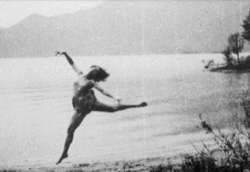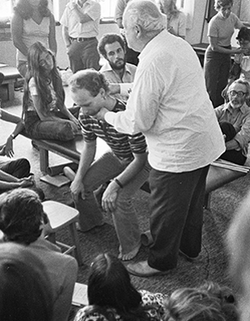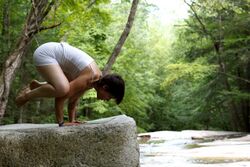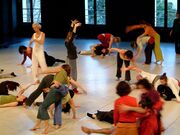Somatics
Topic: Unsolved
 From HandWiki - Reading time: 11 min
From HandWiki - Reading time: 11 min
Somatics is a field within bodywork and movement studies which emphasizes internal physical perception and experience. The term is used in movement therapy to signify approaches based on the soma, or "the body as perceived from within",[1][2] including Skinner Releasing Technique, Alexander technique, the Feldenkrais Method, Eutony Gerda Alexander, Rolfing Structural Integration, among others.[3] In dance, the term refers to techniques based on the dancer's internal sensation, in contrast with "performative techniques", such as ballet or modern dance, which emphasize the external observation of movement by an audience.[4][5] Somatic techniques may be used in bodywork, psychotherapy, dance, or spiritual practices.
History

An early precursor of the somatic movement in Western culture was the 19th-century physical culture movement. This movement sought to integrate movement practices, or "gymnastics", related to military and athletic training; medical treatment; and dance.[7] Many physical culture practices were brought to the US.[8] One particular American innovator, Genevieve Stebbins, developed her own physical culture system.[9] Some of Stebbins's many followers returned to Europe; one of these trained Elsa Gindler, who is recognized as one of the earliest somatic innovators.[10][11][12]
Many further foundational developments in somatics have been traced to the turn of the twentieth century.[6] At that time, the increased popularity of phenomenology and existentialism in philosophy led philosophers such as John Dewey and Rudolf Steiner to advocate experiential learning. Meanwhile, choreographers such as Isadora Duncan, Rudolf von Laban, and Margaret H'Doubler challenged traditional European conceptions of dance, introducing newly expressive and open-ended movement paradigms. Together, these movements set the stage for the first generation of "somatic pioneers", which included Frederick Matthias Alexander, Moshe Feldenkrais, Mabel Elsworth Todd,[13] Gerda Alexander, Ida Rolf,[14] Milton Trager,[15] Irmgard Bartenieff, and Charlotte Selver. These pioneers were active, primarily in Europe, throughout the early twentieth century.[6] Primarily motivated by movement-related injuries of their own, they introduced a variety of techniques intended to help recover from and prevent injury, as well as to enhance physical awareness.[16]
Throughout the twentieth century, this founding generation's practices were codified and passed on by their students, some of whom, including Anna Halprin, Elaine Summers, Bonnie Bainbridge Cohen,[6] and Lulu Sweigard, went on to establish their own influential schools or styles.[17] In the 1970s, American philosopher and movement therapist Thomas Hanna introduced the term "somatics" to describe these related experiential practices collectively.[6][18]
Towards the end of the century, a trend of "cross-fertilization" emerged, with practitioners combining different "lineages" to form idiosyncratic styles.[16] In recent decades, the field of somatics has grown to include dance forms like contact improvisation and Skinner Releasing Technique, and has been used in occupational therapy, clinical psychology, and education.[18]
Movement disciplines
Traditional practices
Many traditional Asian movement disciplines influenced the Western somatic practices that emerged in the twentieth century.[18] Aside of prayer, the oldest and most widely practiced somatic discipline is yoga, but many others exist.[19]
Yoga is a group of physical, mental, and spiritual practices which originated in modern-day India before 500 BCE.[20] The ultimate goals of yoga are spiritual,[21] and yoga practice generally involves physically assuming and moving through codified asanas or body positions. Yoga physiology describes a system of interconnected bodies, having different but interrelated physical and spiritual properties.[22] The concept of energy flow through corporal channels reappears in other somatic forms, including contact improvisation and Qigong.[23][24]
Qigong and tai chi are traditional Chinese movement practices that can serve to support somatic practice. They typically involve moving meditation, coordinating slow flowing movement, deep rhythmic breathing, and calm meditative state of mind. They claim to balance and cultivate qi, translated as "life energy".[15][25] Aikido is a Japanese martial art that includes internal awareness and an emotional state of non-aggression; some styles emphasize this with separate "ki development" training.[15][26]
Exercise practices
The Pilates method was originally developed as a somatic form of physical fitness conditioning in the early 1920s.[27] However, most contemporary forms of Pilates focus on correct physical technique more than proprioceptive awareness.[28] The method's founder, Joseph Pilates, emphasized the somatic principles of mind-body connection, tracking of proprioceptive observations, and attention to breath.[27][28]
Dance
All forms of dance demand the dancer's close attention to proprioceptive information about the position and motion of each part of the body,[29][30] but "somatic movement" in dance refers more specifically to techniques whose primary focus is the dancer's personal, physical experience, rather than the audience's visual one.[5][4] Somatics has been incorporated into dance communities around the world, with variations from country to country due to the history of the field's local introduction as well as broader cultural differences.[16]
Genres
Several dance techniques are considered somatic forms. Contact improvisation is a somatic genre developed by Steve Paxton and others in the 1970s, which consists of two or more dancers responding organically to the physical sensations generated by their mutual contact. Contact improvisation can be performed for an audience, but is not designed to have any particular visual impact.[31]
Ruth Zaporah's Action Theater, developed in the 1970s and 1980s, is an improvisational performance technique based on "'embodied presence', a state of awareness in which performers maintain conscious contact with their somatic experience", according to dance scholar Susanna Morrow.[32]
Education
Some dance educators use somatic principles and training, especially Laban Movement Analysis, Ideokinesis, Alexander, and Feldenkrais, in performative technique classes.[33][34] These practices are used to train dancers' proprioceptive skills and to adjust alignment, and are claimed to reduce the risk of injury.[33][35][36]
Somatic teaching practices are those which build students' awareness of their external environments and internal sensations while dancing. These practices may include making corrections with touch, in addition to verbal instructions; focusing on energy and process, instead of the physical shapes they produce; and deliberately relaxing habitually-overused muscles.[37] Warwick Long claims that using somatics in dance training, by strengthening dancers' knowledge of the soma, makes their technique more "intrinsic, internal and personalised". He claims the direct self-knowledge somatics offers is valuable for today's professional dancers, who are increasingly asked to work outside the structures of canonically codified techniques such as ballet or Graham technique.[38]
Alternative medicine
Several forms of alternative medicine consider sensory experience of the body important.
The Alexander technique, an early example of such a practice, was developed by Frederick Matthias Alexander, an actor, in the 1890s.[39] It is an educational somatic technique intended to undo students' habits of using unnecessary tension in movement.[15][40]
The Feldenkrais Method is a somatic movement pedagogy developed by Moshé Feldenkrais, inspired in part by the Alexander Technique. It claims to improve well-being by bringing attention to movement patterns which proponents claim are inefficient or unnecessarily tense and replacing them with other patterns.[15][41]
Structural Integration, including Rolfing and Hellerwork, uses bodywork, mindfulness, and movement retraining as tools for somatic education. Practitioners claim to make both the body and mind more adaptable and resilient, by improving "alignment" and movement.[42][43]
Trager uses gentle bodywork and relaxed exercises called Mentastics to explore sensation and effortlessness in movement. Practitioners enter a meditative state and attempt to physically communicate a sense of lightness, curiosity, and playfulness via the practitioner's contact. Mentastics is an exploration of body weight in gravity. [44]
Some alternative medicine practitioners who work with mental health have a somatic focus. For example, in somatic experiencing, clients learn to monitor internal sensations.[45]
Spiritual practices
Spiritual discourse within the field of somatics tends to reject monotheistic systems which locate spiritual authority in an external hierarchy, instead sacralizing the direct perception of an internal "life force".[46] Although not strongly aligned with any particular spiritual tradition, somatics literature generally views Christianity and other monotheistic religions unfavorably and favors an eclectic mix of non-Western approaches to the sacred, including those of Buddhism, Taoism, Hinduism, and various kinds of Shamanism.[46]
Some spiritual practices, such as Sufi whirling and Buddhist walking meditation, are particularly associated with somatics.[26][47] Spirituality is a component of the work of Bonnie Bainbridge Cohen, a leader in contemporary somatics who incorporates elements of Zen Buddhism with modern dance and Laban Movement Analysis.[48]
See also
References
Citations
- ↑ Hanna, Thomas (1986). "What is Somatics?". Somatics: Magazine-Journal of the Bodily Arts and Sciences. http://somatics.org/library/htl-wis1.html. Retrieved 17 November 2014.
- ↑ Mullan, Kelly (2012-08-31). "The Art and Science of Somatics: Theory, History and Scientific Foundations". MALS Final Projects, 1995-2019. https://creativematter.skidmore.edu/mals_stu_schol/89.
- ↑ Bresler, L. (2007). International Handbook of Research in Arts Education. Springer International Handbooks of Education. Springer Netherlands. p. 1120. ISBN 978-1-4020-2998-1. https://books.google.com/books?id=nUOJalJZU60C&pg=PA1120. Retrieved 22 June 2016.
- ↑ 4.0 4.1 Williamson, A.; Batson, G.; Whatley, S.; Weber, R. (2015). Dance, Somatics and Spiritualities: Contemporary Sacred Narratives. Intellect. p. 252. ISBN 978-1-78320-178-5. https://books.google.com/books?id=V87BCQAAQBAJ&pg=PA252. Retrieved 16 June 2016. "Somatic Movement is: (a) movement structured around perceptual phenomena, and (b) movement interpreted through perceptual phenomena."
- ↑ 5.0 5.1 Brodie, J.A.; Lobel, E.E. (2012). Dance and Somatics: Mind-Body Principles of Teaching and Performance. McFarland & Company. p. 6. ISBN 978-0-7864-8958-9. https://books.google.com/books?id=pCROxt0OUSUC&pg=PA6. Retrieved 16 June 2016. "The focus is on the individual experience: how we feel as opposed to how others perceive or how we think we are being perceived."
- ↑ 6.0 6.1 6.2 6.3 6.4 Eddy, Martha (2009). "A brief history of somatic practices and dance: historical development of the field of somatic education and its relationship to dance". Journal of Dance and Somatic Practices 1 (1): 5–27. doi:10.1386/jdsp.1.1.5_1. http://wellnesscke.net/downloadables/AbriefhistoryofSomaticanddance.pdf. Retrieved 6 November 2014.
- ↑ Mullan, Kelly Jean (2014-10-02). "Somatics: Investigating the common ground of western body–mind disciplines" (in en). Body, Movement and Dance in Psychotherapy 9 (4): 253–265. doi:10.1080/17432979.2014.946092. ISSN 1743-2979. http://www.tandfonline.com/doi/abs/10.1080/17432979.2014.946092.
- ↑ Mullan, Kelly. (2016). "European Antecedents to Somatic Movement." Chapter in Mindful Movement: The Evolution of the Somatic Arts and Conscious Action, ed. Martha Eddy.
- ↑ Mullan, Kelly (2016) "Harmonic Gymnastics and Somatics: A Genealogy of Ideas." Currents: Journal of the Body-Mind Centering Association, 19:1, 16-28.
- ↑ Mullan, Kelly Jean (2017-09-01). "Somatics herstories: Tracing Elsa Gindler's educational antecedents Hade Kallmeyer and Genevieve Stebbins" (in en). Journal of Dance & Somatic Practices 9 (2): 159–178. doi:10.1386/jdsp.9.2.159_1. ISSN 1757-1871. https://doi.org/10.1386/jdsp.9.2.159_1.
- ↑ Speads, Carola; Speads, Carola H. (April 1992) (in en). Ways to Better Breathing. Inner Traditions / Bear & Co. ISBN 978-0-89281-397-1. https://books.google.com/books?id=6raSuDun7wcC.
- ↑ Geuter, Ulfried; Heller, Michael C.; Weaver, Judyth O. (2010). "Elsa Gindler and her influence on Wilhelm Reich and Body Psychotherapy". Body, Movement & Dance in Psychotherapy 5 (1): 59–73. doi:10.1080/17432971003620113.
- ↑ Fraleigh, S. (2015). Moving Consciously: Somatic Transformations through Dance, Yoga, and Touch. University of Illinois Press. p. 26. ISBN 978-0-252-09749-2. https://books.google.com/books?id=Z0AoCgAAQBAJ&pg=PA26. Retrieved 2016-06-14.
- ↑ Claire, Thomas (1995). Bodywork: What Type of Massage to Get and How to Make the Most of It. William Morrow and Co.. pp. 40–56. ISBN 9781591202325. https://archive.org/details/bodywork00thom.
- ↑ 15.0 15.1 15.2 15.3 15.4 Knaster, Mirka (1996). Discovering the Body's Wisdom: A Comprehensive Guide to More Than Fifty Mind-Body Practices. Bantam. pp. 188–245, 326–51. ISBN 9780307575500.
- ↑ 16.0 16.1 16.2 Fortin, Sylvie (2002). "Living in Movement: Development of Somatic Practices in Different Cultures". Journal of Dance Education 2 (4): 128–136. doi:10.1080/15290824.2002.10387221.
- ↑ Franklin, Eric. (1996). Dynamic Alignment Through Imagery. Champaign, IL: Human Kinetics. p. 4. ISBN 978-0-87322-475-8. https://books.google.com/books?id=CBwV_g8DhEMC.
- ↑ 18.0 18.1 18.2 Allison, N. (1999). The Illustrated Encyclopedia of Body-mind Disciplines. Gale virtual reference library. Rosen Publishing Group. ISBN 978-0-8239-2546-9. https://archive.org/details/illustratedencyc00alli. Retrieved 16 June 2016.
- ↑ Eleanor Criswell (2011). "Somatics and Surface Electromyography". in Cram, James. Cram's Introduction to Surface Electromyography. Jones & Bartlett Learning. p. 193. ISBN 9780763732745. https://books.google.com/books?id=RgfX5jXrmzMC&q=somatics&pg=PA193. Retrieved 1 March 2015.
- ↑ Samuel, Geoffrey (2008). The Origins of Yoga and Tantra. Cambridge University Press. ISBN 978-0-521-69534-3. https://books.google.com/books?id=JAvrTGrbpf4C.
- ↑ Jacobsen, Knut A.; Larson, Gerald James (2005). Theory And Practice of Yoga: Essays in Honour of Gerald James Larson. BRILL. ISBN 978-90-04-14757-7. https://books.google.com/books?id=TDGFFNYvrokC.
- ↑ Frawley, David (2004). Yoga and the Sacred Fire: Self-Realization and Planetary Transformation. Lotus Press. p. 288. ISBN 978-81-208-2746-2.
- ↑ Dills, Ann; Albright, Ann Cooper (2001). Moving History/Dancing Cultures: A Dance History Reader. Wesleyan University Press. p. 406. ISBN 9780819574251. https://books.google.com/books?id=pFcVAgAAQBAJ&q=energy+flow+contact+improv&pg=PA406. Retrieved 7 November 2014.
- ↑ Oh; Butow; Mullan; Clarke; Beale; Pavlakis; Kothe; Lam et al. (31 August 2009). "Impact of Medical Qigong on quality of life, fatigue, mood and inflammation in cancer patients: a randomized controlled trial". Annals of Oncology 21 (3): 608–614. doi:10.1093/annonc/mdp479. PMID 19880433.
- ↑ Cohen, K. S. (1999). The Way of Qigong: The Art and Science of Chinese Energy Healing. Random House of Canada. ISBN 978-0-345-42109-8.
- ↑ 26.0 26.1 Payne, Peter; Crane-Godreau, Mardi (24 July 2013). "Meditative movement for depression and anxiety". Frontiers in Psychiatry 4: 71. doi:10.3389/fpsyt.2013.00071. PMID 23898306.
- ↑ 27.0 27.1 "Pilates, Mindfulness and Somatic Education.". J Dance Somat Pract 5 (2): 141–153. 2013. doi:10.1386/jdsp.5.2.141_1. PMID 25328542.
- ↑ 28.0 28.1 Rouhiainen, Leena (2010). "The Evolvement of the Pilates Method and its Relation to the Somatic Field". Nordic Journal of Dance 2: 57–69. http://www.nordicjournalofdance.com/TheEvolvement.pdf. Retrieved 17 November 2014.
- ↑ Smitt, Myrim Sillevis; Bird, H. A. (2013). "Measuring and enhancing proprioception in musicians and dancers". Clin Rheumatol 32 (4): 469–473. doi:10.1007/s10067-013-2193-7. PMID 23397145.
- ↑ Bläsing, Bettina; Calvo-Merino, Beatriz; Cross, Emily S.; Jola, Corinne; Honisch, Juliane; Stevens, Catherine J. (2012). "Neurocognitive control in dance perception and performance". Acta Psychologica 139 (2): 300–308. doi:10.1016/j.actpsy.2011.12.005. PMID 22305351. http://epubs.surrey.ac.uk/294638/1/Blaesingetal_NeurocognitiveControlinDance_ActaPsy_2012.pdf.
- ↑ Novac, Cynthia Jean (1990). Sharing the Dance: Contact Improvisation and American Culture. University of Wisconsin Press. ISBN 978-0-299-12440-3. https://books.google.com/books?id=YNULSI5C580C&q=contact+improvisation&pg=PR11. Retrieved 14 December 2014.
- ↑ Morrow, S. (2011). "Psyche meets Soma: accessing creativity through Ruth Zaporah's Action Theater.". Theatre, Dance and Performance Training 1 (2): 99–113. doi:10.1080/19443927.2010.543987.
- ↑ 33.0 33.1 Brodie, Julie; Lobel, Elin (2004). "Integrating Fundamental Principles Underlying Somatic Practices into the Dance Technique Class". Journal of Dance Education 4 (3): 80–87. doi:10.1080/15290824.2004.10387263.
- ↑ Eddy, Martha Hart (2002). "Dance and Somatic Inquiry in Studios and Community Dance Programs". Journal of Dance Education 2 (4): 119–127. doi:10.1080/15290824.2002.10387220.
- ↑ Wozny, Nancy (May 2012). "The Somatics Infusion". Dance Magazine. http://www.dancemagazine.com/issues/May-2012/The-Somatics-Infusion. Retrieved 14 December 2014.
- ↑ Fortin, Sylvie; Long, Warwick; Lord, Madeleine (2002). "Three Voices: Researching how somatic education informs contemporary dance technique classes". Research in Dance Education 3 (2): 155–179. doi:10.1080/1464789022000034712.
- ↑ Nettl-Fiol, Rebecca; Vanier, Luc (2011). Dance and the Alexander Technique: Exploring the Missing Link (illustrated ed.). University of Illinois Press. p. 12. ISBN 9780252077937. https://books.google.com/books?id=EcqCFdMPIYwC&q=Dance%20and%20the%20Alexander%20Technique%3A%20Exploring%20the%20Missing%20Link&pg=PA12. Retrieved 28 February 2015.
- ↑ Long, Warwick (2002). Sensing Difference: Student and Teacher Perceptions on the Integration of the Feldenkrais Method of Somatic Education and Contemporary Dance Technique (PDF) (M.P.Ed.). International Feldenkrais® Federation. Retrieved 6 November 2014.
- ↑ Rootberg, Ruth (September 2007). Mandy Rees. ed. "Voice and Gender and other contemporary issues in professional voice and speech training". Voice and Speech Review 35 (1): 164–170. doi:10.1080/23268263.2007.10769755.
- ↑ Rosenberg, Bobby. "The Alexander Technique and Somatic Education". http://alexandertechnique.com/resources/rosenberg.pdf. ""[Alexander's] frequent references to "kinesthesia", "sensory awareness", and "feeling" place him squarely in the center of the field of somatics."
- ↑ Levine, Andrew (1998). The Bodywork and Massage Sourcebook. Lowell House. pp. 249–60. ISBN 9780737300987. https://archive.org/details/unset0000unse_k8j9.
- ↑ Levine, Andrew (1998). The Bodywork and Massage Sourcebook. Lowell House. pp. 209–234. ISBN 9780737300987. https://archive.org/details/unset0000unse_k8j9.
- ↑ Behnke, Elizabeth A. (1998). "Matching". Somatics (Spring/Summer 1998): 24–32., found in Johnson, Don, ed (1995). Bone, Breath & Gesture: Practices of Embodiment. North Atlantic Books. pp. 317–338. ISBN 9781556432019. https://books.google.com/books?id=iVtdDKqG1uoC&q=somatics%20bodywork%20317&pg=PA317. Retrieved 28 February 2015.
- ↑ Stillerman, Elaine (2016). Modalities for Massage and Bodywork (second ed.). Mosby. pp. 366–83, 402–14. ISBN 9780323239318.
- ↑ Levine, Peter A. with Frederick, Ann: Waking the Tiger. Healing Trauma. North Atlantic Books, Berkeley, CA, 1997 ISBN:1-55643-233-X
- ↑ 46.0 46.1 Williamson, Amanda (2010). "Reflections and theoretical approaches to the study of spiritualities within the field of somatic movement dance education". Journal of Dance and Somatic Practices 2 (1): 35–61. doi:10.1386/jdsp.2.1.35_1.
- ↑ Holland, D. (2004). "Integrating Mindfulness Meditation and Somatic Awareness into a Public Educational Setting". Journal of Humanistic Psychology 44 (4): 468–484. doi:10.1177/0022167804266100.
- ↑ Eddy, Martha (2002). "Somatic Practices and Dance: Global Influences". Dance Research Journal 34 (2): 46–62. doi:10.2307/1478459.
General bibliography
- Allison, Nancy, ed (1999). The Illustrated Encyclopedia of Body-mind Disciplines (illustrated, annotated ed.). Taylor & Francis. ISBN 9780823925469. https://books.google.com/books?id=5199jcnbqwEC&q=allison%20n%20illustrated%20encyclopedia%20of%20mind-body%20disciplines&pg=PP1. Retrieved 1 March 2015.
- Brodie, Julie A.; Lobel, Elin E. (2012). Dance and Somatics: Mind-Body Principles of Teaching and Performance. McFarland. ISBN 9780786489589. https://books.google.com/books?id=pCROxt0OUSUC&q=somatics&pg=PP1.
External links
 |
 KSF
KSF


